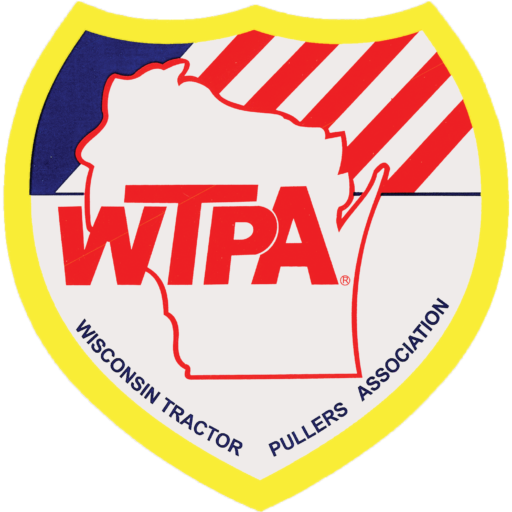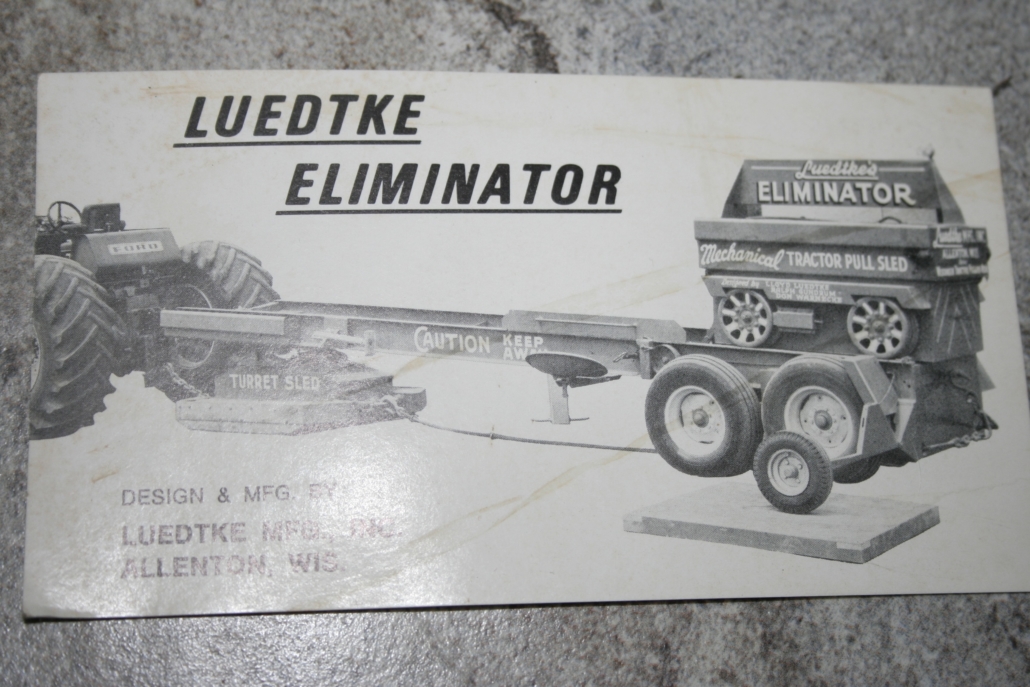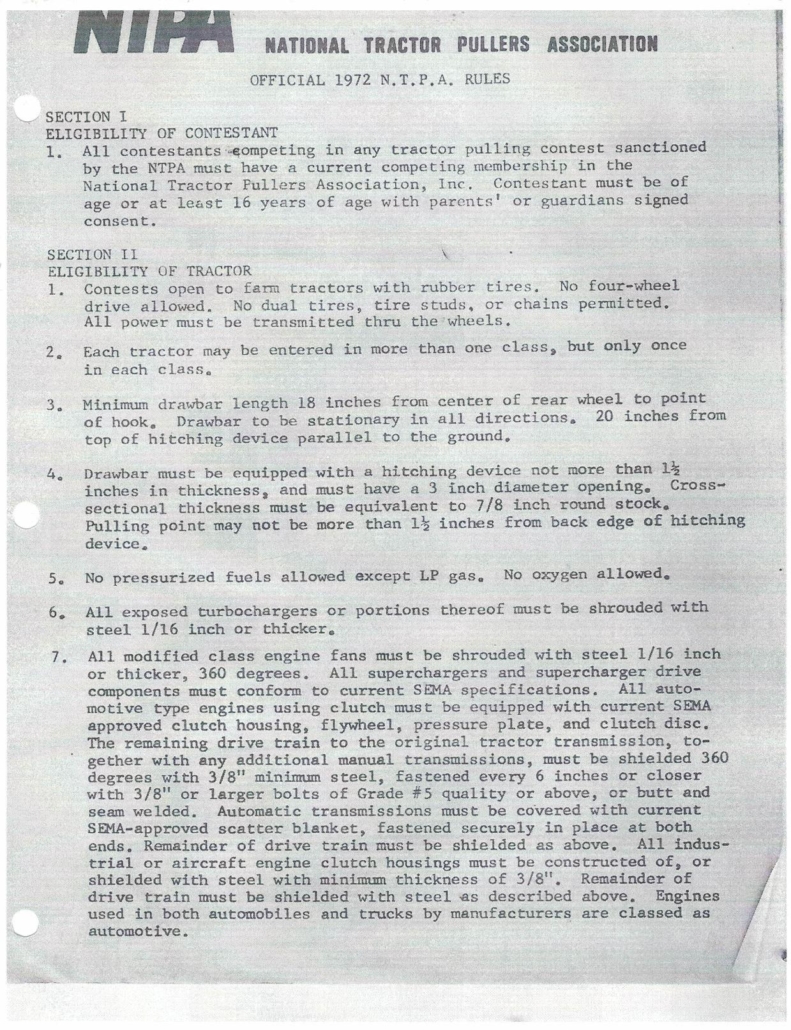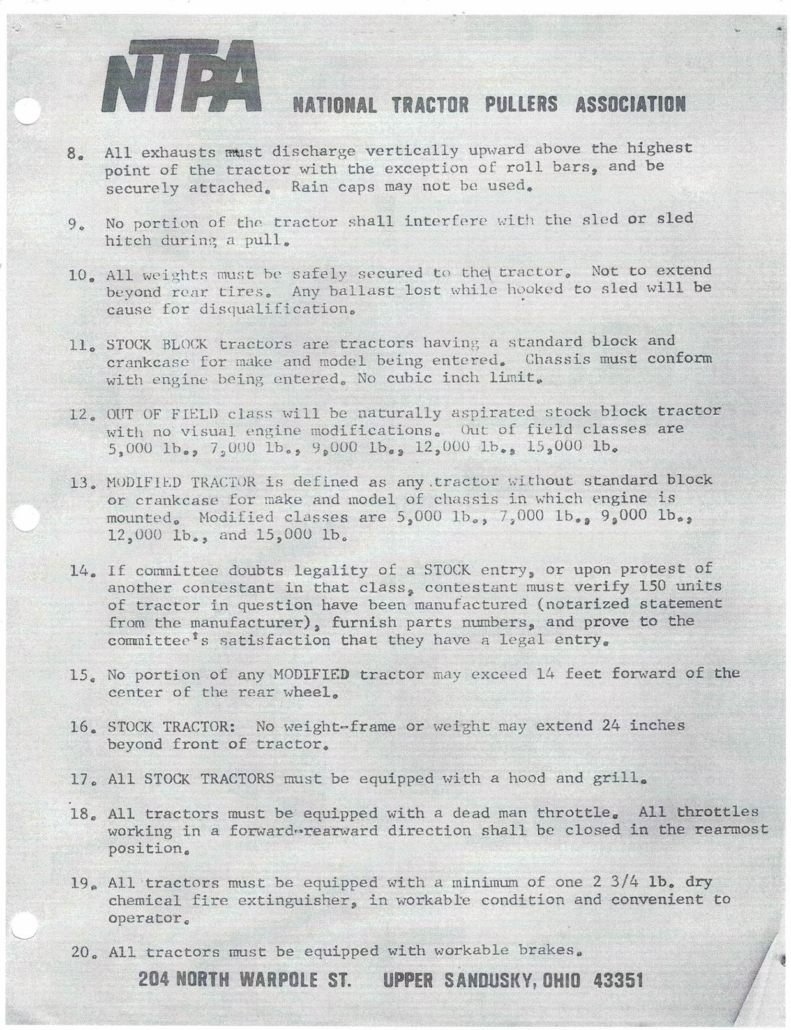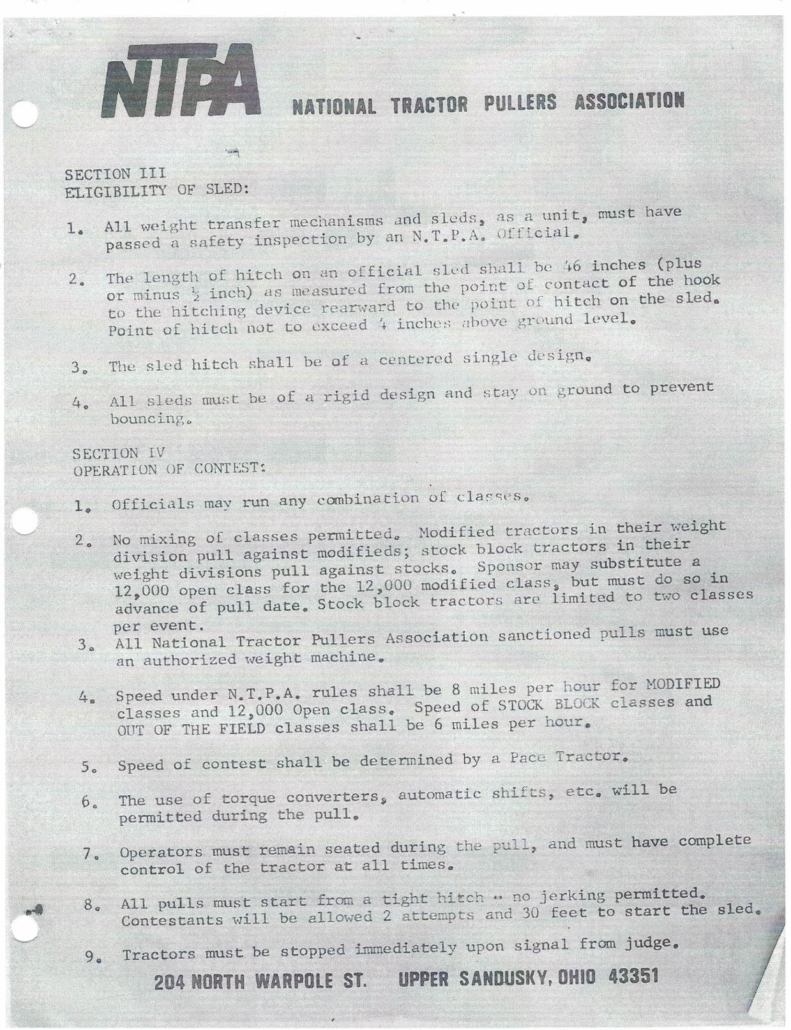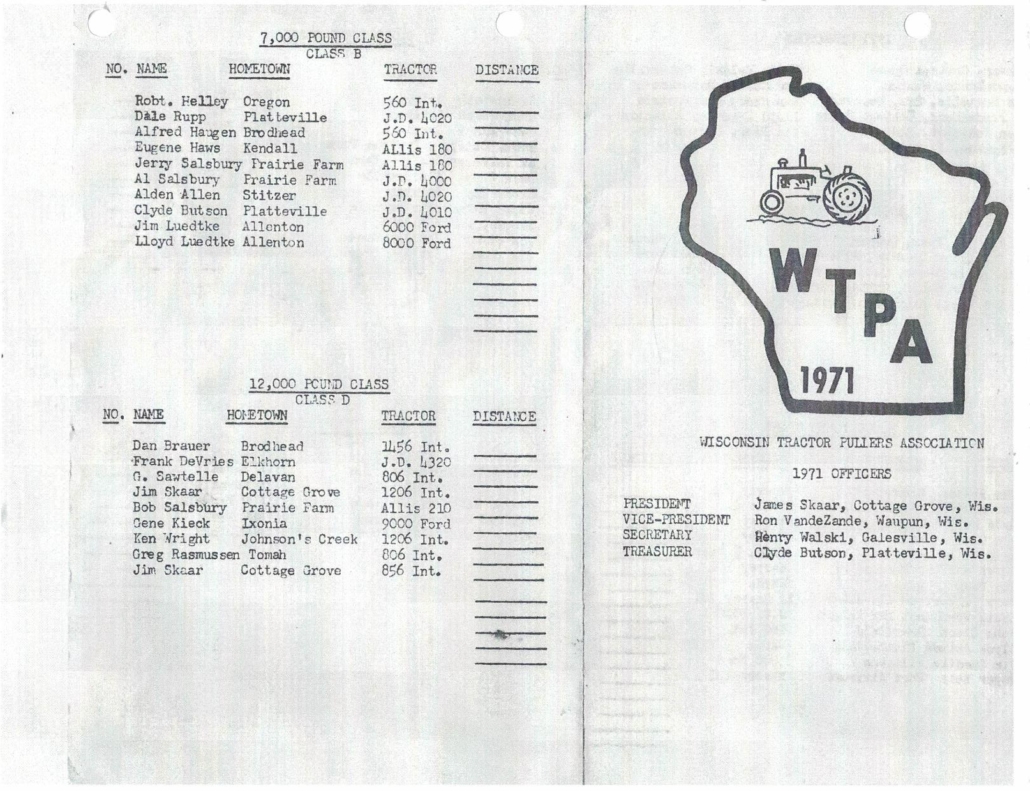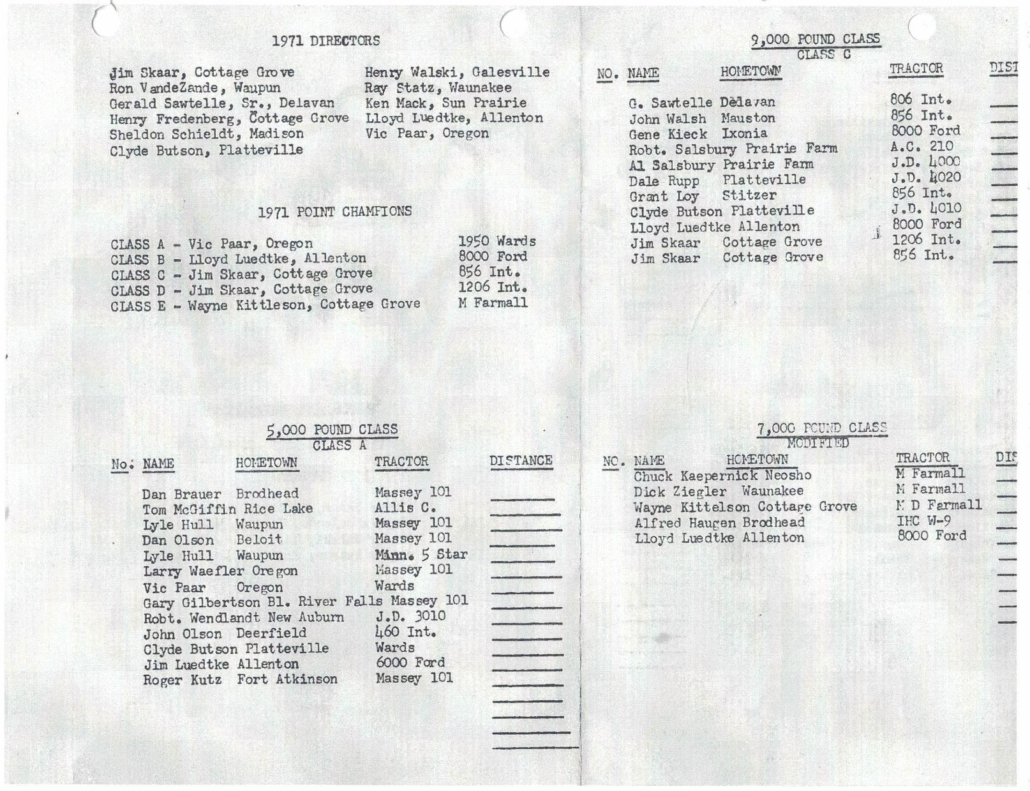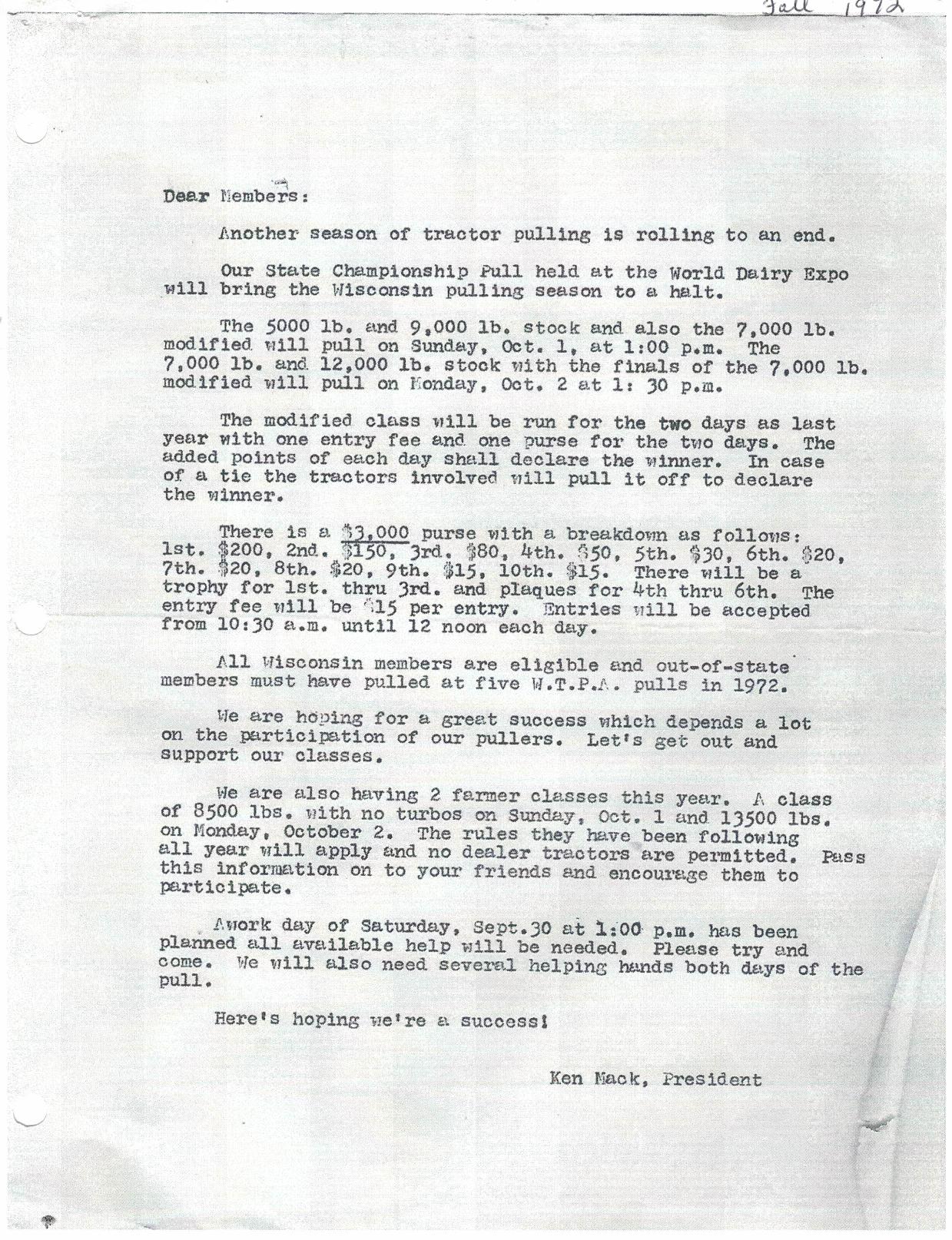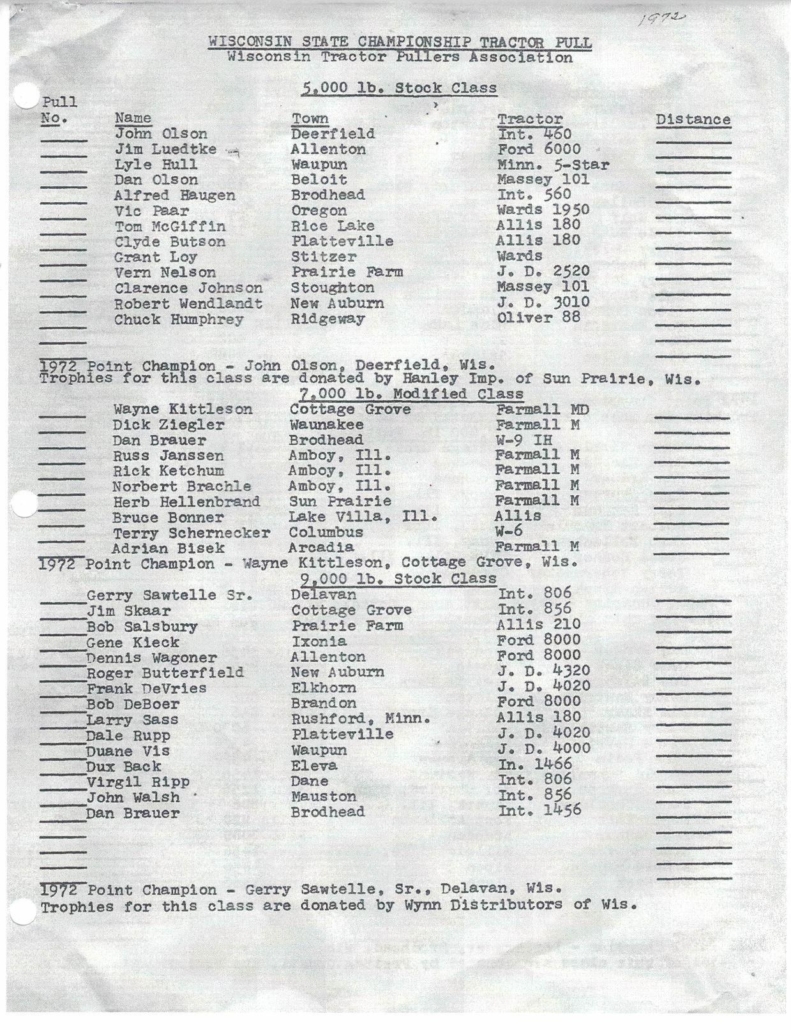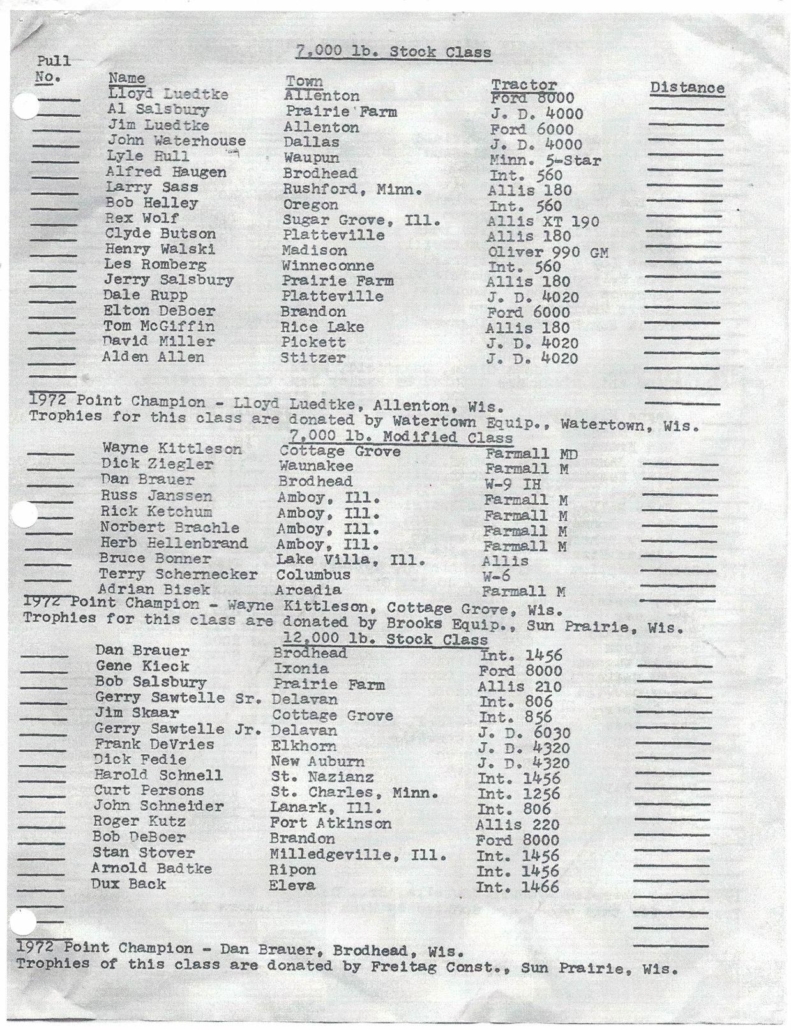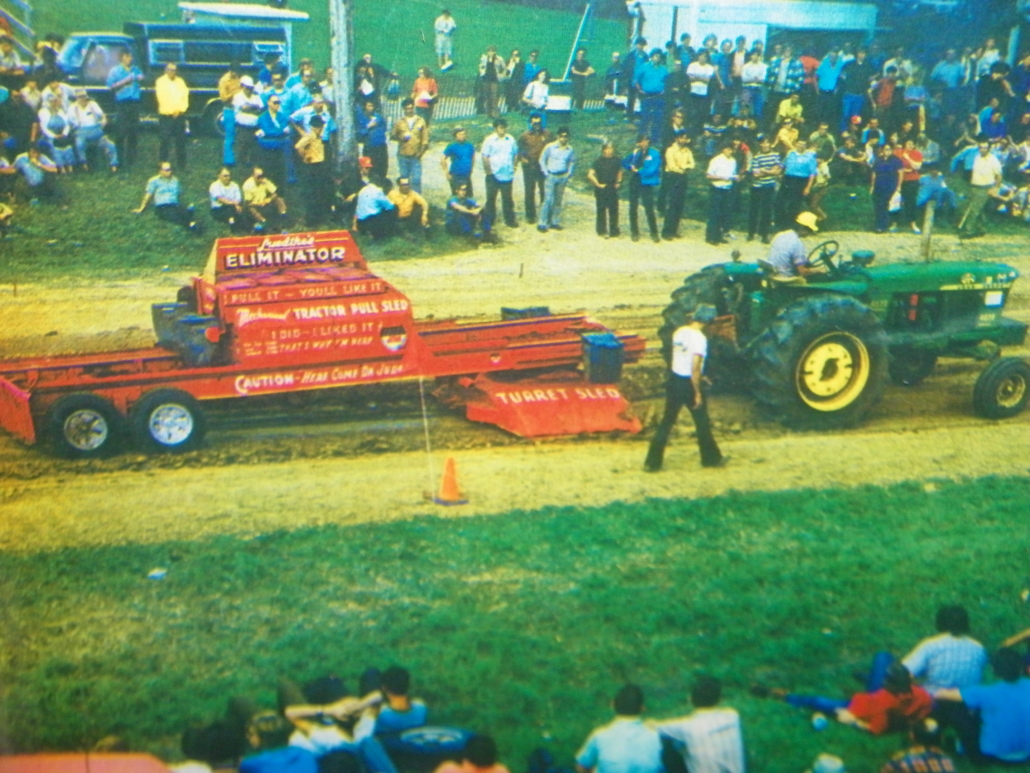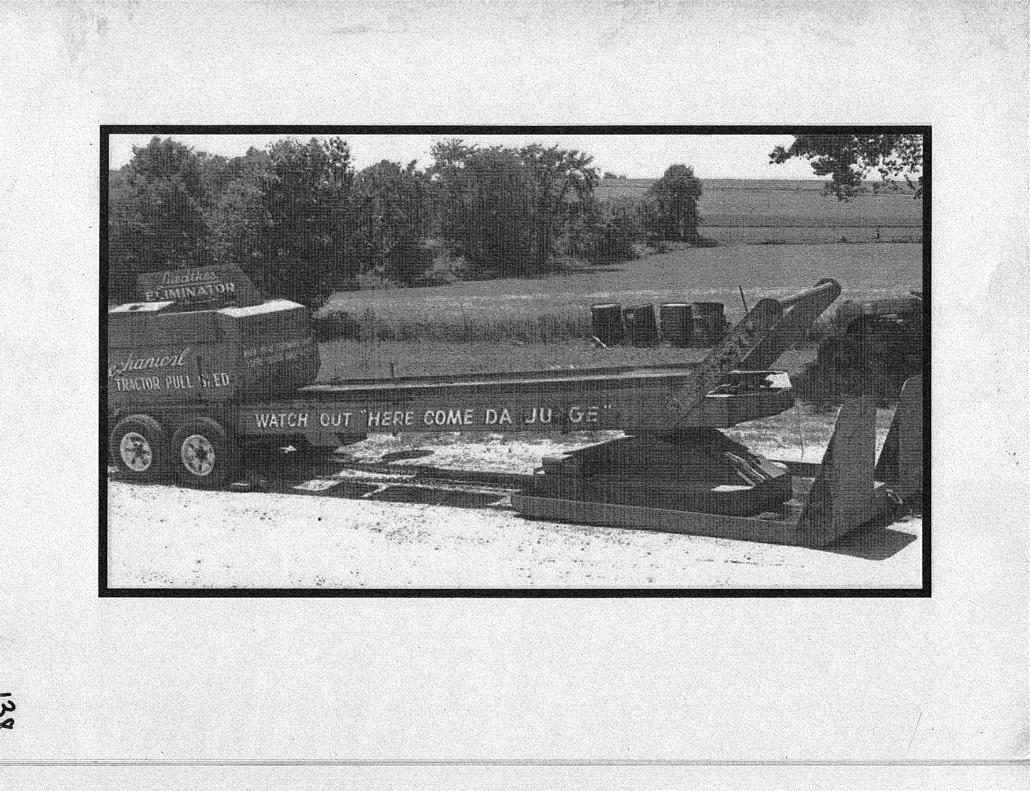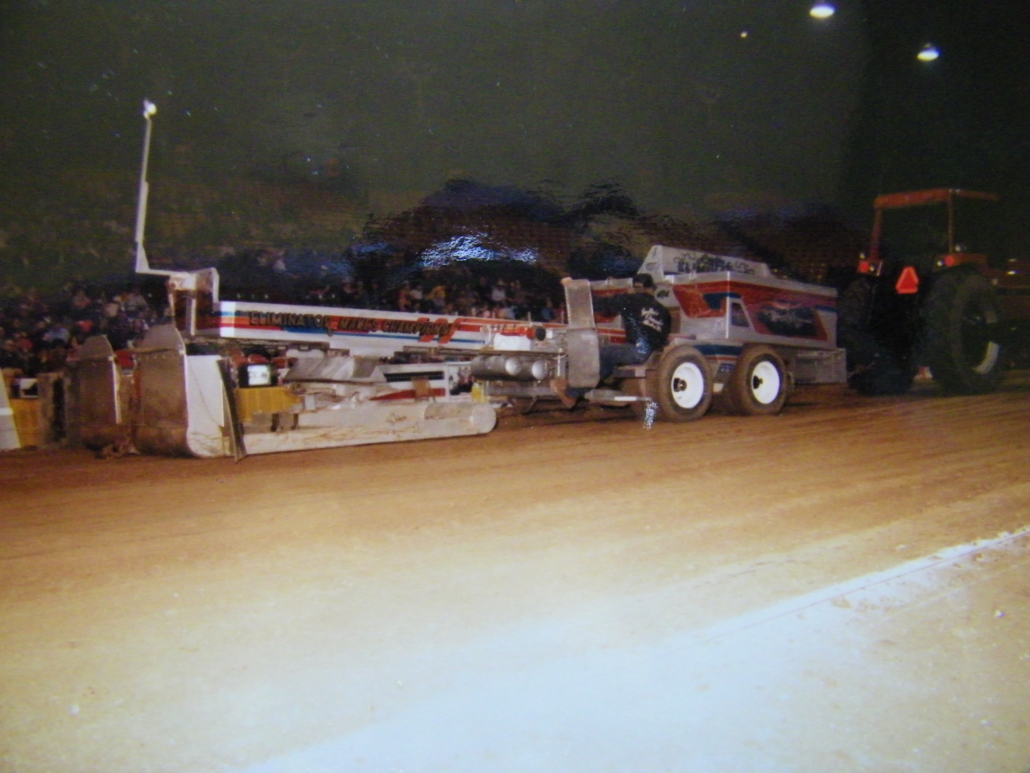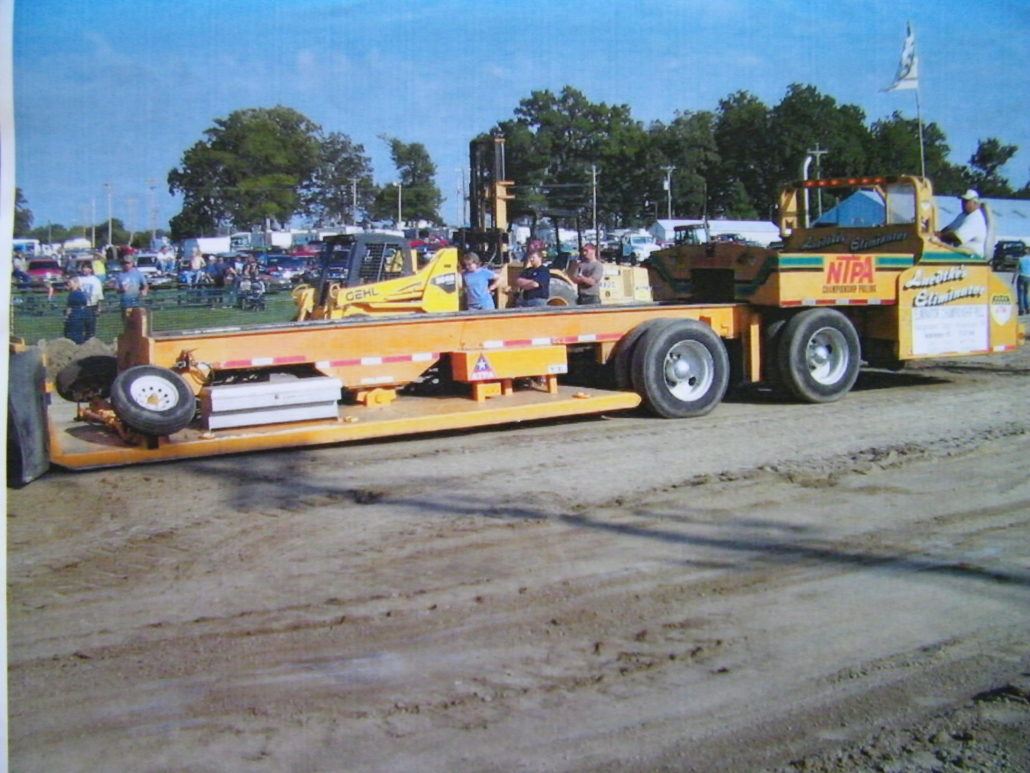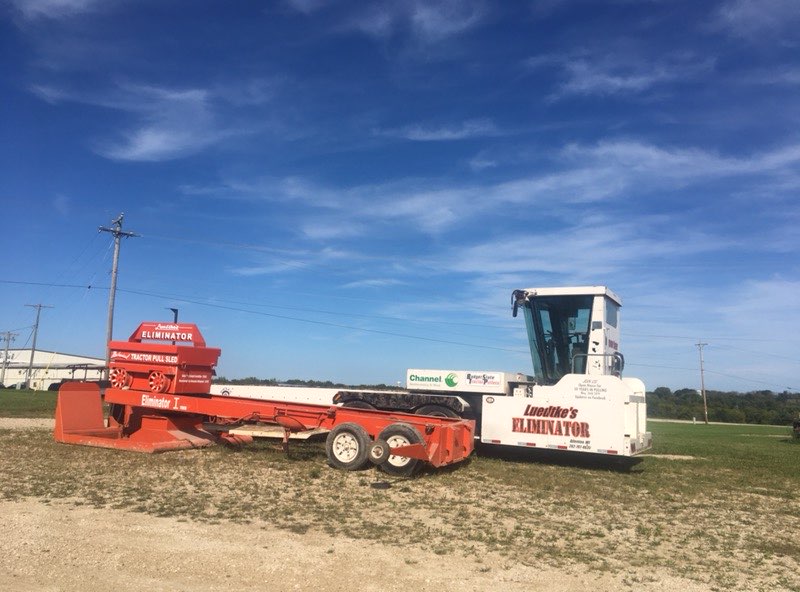Growing of the Association and the Luedtke Influence!
The story of the beginning of the Wisconsin Tractor Pullers Association (WTPA) was influenced by pullers who were interested in pulling under a consistent set of rules for safety reasons. When talking about the people who worked towards this goal, one name must be part of that discussion, Lloyd Luedtke. For anyone not familiar with the pulling world, the name of Lloyd Luedtke is someone who was an early advocate for safety, who also happened to be an innovator for building pulling sleds. He was a promoter of the sport of pulling and a supporter of the state’s association by helping to increase the number of pulls offered and encouraging people to build their own pulling vehicle.
When you talk about Lloyd, you must also talk about his son, Jim Luedtke. Jim was recently interviewed to hear his memories of these early days in WTPA’s story. He grew up in pulling with his father who was a mover and a shaker. Jim was able to provided us with some interesting stories!
Jim recalls that Lloyd had heard about a meeting in Upper Sandusky, Ohio, where representatives from several states were interested in creating a national pulling organization. In April or May, 1969, Lloyd and Jim (who was about 14 years old at the time) drove out to Upper Sandusky, Ohio, to Ed Hart’s home and were part of this organizational meeting with representatives from five other states. The result of this meeting was the formation of the National Tractor Pullers Association (NTPA). Jim recalls that five states were part of the formation of the original NTPA. These states included Illinois, Indiana, Michigan, Ohio, and Missouri with Pennsylvania, Iowa, and Minnesota adding later that year. Wisconsin would join the NTPA in spring of 1971. Jim was pretty proud of the fact that he and his dad were there when during the inception of the NTPA!
Influence In Other Countries
Jim recalls that in 1974 his dad, Jim Skaar and Frank DeVries, loaded up their tractors and sled and went to Saskatoon, Saskatchewan Canada to put on a pulling demonstration. There was a lot of interest in pulling in that region that lead to it becoming a major sport in Saskatchewan.
In 1985, a group of people from Germany came to the United States to watch pulling. They attended the Tomah pull and were looking for Lloyd as they wanted to talk with him about the sleds and somehow they knew he spoke German. Lloyd grew up speaking German at home and learned English when he started going to school. Lloyd would invite the Germans down to Allenton to visit sometime while they were in America. When Lloyd got home from the Tomah pull, the Germans were waiting for him at his house! Over the next few months, Lloyd kept in contact with these individuals and in the early year 1986, Lloyd would spend 6 weeks in Germany to help them build a pulling sled.
Early Founders
Several names occur frequently in the minutes from the 1970-72 era. Jim recalled several of these people and provided some background to their connections to the WTPA and pulling. Henry Fredenberg was at the original meetings and he became the first WTPA president. Jim reported that Henry is still around and Jim still sees him at tractor pulls. James Skaar was the second WTPA president and he was an active puller for many years. His son is Punky Skaar and Punky still pulls a Super Farm named “Screamin’ Norwegian”. Lyle Uphoff was on the Board of Directors for several years who is a relative to Bob Uphoff, a current WTPA member and pulls in the Modified Mini Tractor class. Clyde Butson was also active on the board for several years. He pulled an Allis Chalmers in 1972-73. His son is Stacy Butson who is an announcer for Badger State pulls. Dan Brauer, also a board member, traveled with Al Haugen and ran a 1456 International. Al Haugen was well known for his super stock called “Haugen’s Hero”. Jim stated that Al’s first tractor was a modified. He also had two tractors with V-8 Olds power plants.
Ken Mack was the third WTPA president. He had an active role in the direction of WTPA for most of the first 50 years. Ken was an ag equipment salesman for Hanley Implement for most of his career. Kenny pulled with WTPA in 1970, and he was a flag man in 1971. He had an accident in 1971 when a John Deere backed into him while he was unhooking the tractor from the sled. After that, Ken found his way into the announcing booth and that is where he made his name in pulling. Ken announced WTPA pulls for over 35 years. He also announced prestigious national pulls like Tomah and Bowling Green. You may recognize his name on the announcers tower at Recreation Park, home of the Budweiser Dairyland Super National Pull in Tomah. Ken unfortunately passed away in 2019.
Frank Devries’ name is also found in some of the early minutes. Frank had 2 tractors at the time and ran an implement dealership in Elkhorn, WI. He and Lloyd became good friends over the years. Later he helped Lloyd run sleds and helped get them to and from pulls. Now Frank’s son Mike helps Jim with the operation of the sleds.
Jack Frietag was another person involved in the first few years of the organization. Jack sold farm equipment for a living. Jack and his wife, Joyce, were good friends with Jim and Nola Skaar and were often seen together at pulls. Jack owned the modified tractor the “Fudmobile” which was built and run by Wayne Kittleson. This tractor was the first state Modified champion and it held that title for several years.
Jim Luedtke has also left his mark on the WTPA organization. He won the 1973 state championship for the 5,000 lb. Super Stock class by beating out Vic Poor with the Luedtke Ford 6000, he was 19 at the time. Jim served on the WTPA board for several years and was president in 1995 and 1996. He recalls going round and round with Dick Ziegler, also on the board, about allowing the super stock trucks into WTPA in the mid-1990’s. Dick wasn’t too keen on the idea while Jim felt that the class would be a good addition to the WTPA lineup of classes. Eventually this class was added and has become what we currently know as the Modified Four Wheel Drive Truck class.
To show how times have changed, Jim told of a framed poster that he has in his shop from the 1973 Winnebago County Fair in Oshkosh and the total purse for that event was $1,800!
Rule Changes
In April 1971, the WTPA board voted to join the NTPA. The original classes were out-of-the-field tractors and farmers would make changes to their farm tractors to increase power when going to a pull. Other pullers built a vehicle just for pulling. Some unusual combinations were seen with car engines used. Any vehicle that didn’t fit into a “stock” class was put into the “open” class. Jimmy said that it was like the wild west at that time.
In 1971, NTPA offered the first V-8 class which was to become the Modified class. The original WTPA rules required a hood and grill on all vehicles which gave the early “Mods” the look of a stock tractor. In 1972 when the WTPA started using the NTPA rules, the hood and grill were not required anymore. That was the first step towards the modern Modified Tractor look as we know today.
Jim talked about the early NTPA meetings where the rules were made by the pullers. He said it was three days of knock-down, drawn-out arguing. The pullers would “bring their tractors” to the meeting, meaning they would want to change the rules to fit their vehicle or class. It was a difficult way to make rule changes that were good for the organization. Over the years the system for changing rules shifted to what it is today with input from the national board and influence from lawyers and insurance companies.
Growing the Association
Now that the WTPA had become a member state of the NTPA, had improved rules for safety, and had a mechanical sled to provide a smoother, safer pull, there was a need to increase the number of pulls in the state. In the March 1972 Membership meeting minutes, the following entry was made: “Ken Mack, president, explained to the members that Lloyd Luedtke would donate $25.00 to anyone locating a pull on a new site for the Association.” Lloyd provided motivation for others to get involved and to help grow the pulling schedule.
What Pulling Looked Like
This video from Elkhorn, WI in 1977 is historically important in WTPA history. First, it shows a classic Lloyd Luedtke as many of us remember him, shirt off and walking alongside the track with the sled. He does his little hop and twist of his wrist at the end of the pull which was a frequent movement by Lloyd. The announcer is Alice DeVries, wife of Frank DeVries who was one of the first women announcers in tractor pulling and the only woman announcer in the WTPA to this day. This was one of the few times that she had announced a pull. The tractor that’s pulling is Wayne Kittelson with the “Fudmobile” modified tractor. This was the tractor to beat in the modified class. Notice the driver is not wearing a helmet or fire suit, and there is no rollcage on the tractor. Those rules did not exist at the time of this pull. Also, notice the sled operator sitting on the side of the sled and how he gets lost in the dust cloud. Thanks to Beer Money Pulling Team and for sharing this video from their Facebook page. Video was sent courtesy of Kyle Kittleson.
Today
Today, Jim and his wife, Debbie, continue to run the pulling sled business along with a trucking business. Jim now runs with NEW Motorsports, Badger State Trucks, Badger State Tractor Pullers, as well as pulls in Iowa and Minnesota. In 2019, the Luedtke sleds celebrated their 50th anniversary in pulling. Jim and Debbie put on an open house for this milestone anniversary and had over 1,500 people attend!
Jim provided a lot of insights into the early days of WTPA and how his father and others worked to develop the classes and grow the number of pulls. We would like to give a HUGE thank you to Jim and Debbie for taking the time to share these stories!
Rules
In 1972 WTPA started using the NTPA rules which fit on 4 pages.
State Championship Program
The following two programs show the names of pullers, their vehicles, and where they lived for each class. Notice that the 1971 program lists the classes as Class A, B, C, D, E. In 1972, the classes are listed by weight. The programs also provided a place to write down distances.
Evolution of the Luedtke Sleds
The original Luedtke sled.
The original sled with pan changes.
Last sled the operator sat on the side of the sled.
First sled the operator sat at the back, no cab.
Comparison of the original sled and the current Luedtke sled.
